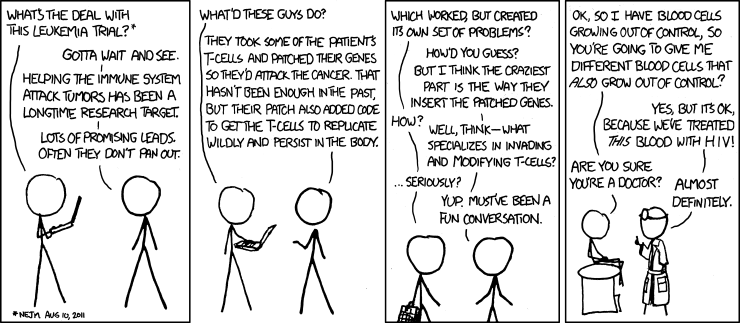My take on the crizotinib Xalkori FDA approval
Pfizer’s Crizotinib (Xalkori) approved in ALK-positive lung cancer!
The FDA just announced that they have approved Pfizer’s crizotinib (Xalkori):
The U.S. Food and Drug Administration today approved Xalkori (crizotinib) to treat certain patients with late-stage (locally advanced or metastatic), non-small cell lung cancers (NSCLC) who express the abnormal anaplastic lymphoma kinase (ALK) gene.
Xalkori is being approved with a companion diagnostic test that will help determine if a patient has the abnormal ALK gene, a first-of-a-kind genetic test called the Vysis ALK Break Apart FISH Probe Kit. It is the second such targeted therapy approved by the FDA this year.
Source FDA
This is wonderful news for those unfortunately affected by this debilitating disease and those yet to be diagnosed with the aberration who will be able to be treated with a new highly specific and targeted drug.
ALK aberrations typically occur in the order of 4-7% of NSCLC patients, depending on sources. No doubt the companion FISH diagnostic test from Abbott will make it easier to screen and identity patients. In turn this will help determine which patients with lung cancer are eligible for treatment.
Pfizer began the rolling NDA submission in January and completed it in May, giving a PDUFA date around November 17th. This rapid approval in approx. three months continues the 2-3 month trend seen with cabazitaxel (Jevtana) and abiraterone (Zytiga) in castration-resistant prostate cancer (CRPC), and vemurafenib (Zelboraf) in metastatic melanoma.
The Xalkori story has been nothing short of amazing and represents another major advance for targeted therapy in a clearly identified subset of patients. There are several patient stories that I’ve come across on the internet, most are heart warming – take a look at this snippet I have curated from ‘feel good’ anecdotes from a caregiver this month alone:
View “Does crizotinib work in ALK+ lung cancer?” on Storify
It’s amazing to follow their story of courage and grace under pressure; it is also very hard to have a bad hair day when the very fragility of human life stares at you in the face. It could be any of us under 50, even non-smokers.
The response rates to crizotinib have been incredible, as witnessed by Dr Jack West’s story about one of his patients at Swedish:
{Update 1: Dr West tells me that the young gentleman he referred to in his TED story has now been on crizotinib 2+ years and is doing well enough to coach soccer!}
In the final PI, the overall response rates for Xalkori in two single arm studies (n=136 and 119) in patients who had mostly received prior systemic therapy. They differed in that:
“In Study A, ALK-positive NSCLC was identified using the Vysis ALK Break-Apart FISH Probe Kit. In Study B, ALK-positive NSCLC was identified using a number of local clinical trial assays.”
The ORR was 50% and 61% for each respectively. This is pretty impressive, in my opinion. According to the PI, the adverse event profile is quite tolerable:
“The most common adverse reactions (≥25%) across both studies were vision disorder, nausea, diarrhea, vomiting, edema, and constipation.
Grade 3-4 adverse reactions in at least 4% of patients in both studies included ALT increased and neutropenia.”
These are fairly normal and commonplace for cancer therapy, although there are potential vision disturbances that may need to be watched (from the PI):
“Vision disorders including visual impairment, photopsia, vision blurred, vitreous floaters, photophobia, and diplopia were reported in 159 (62%) patients in clinical trials.
These events generally started within two weeks of drug administration.
Ophthalmological evaluation should be considered, particularly if patients experience photopsia or experience new or increased vitreous floaters.
Severe or worsening vitreous floaters and/or photopsia could also be signs of a retinal hole or pending retinal detachment.”
The good news is that Xalkori is now available – according to the Pfizer press release:
XALKORI is available immediately through a number of specialty pharmacies.
Patients prescribed XALKORI can call 1-877-744-5675 for assistance accessing the medication.For more information about the FDA-approved ALK test, call (855) TEST-ALK (837-8255).
The big question many will be asking, though, is what’s the price?
Answer: Price: $9,600/month, putting it in line with similar pricing to Roche’s Zelboraf in metastatic melanoma.
{Update 2: Abbott has also received approved for the ALK test although no information on the cost of the test was provided}.


 Last month, a critical paper was published in
Last month, a critical paper was published in  Today several people have reminded me that it’s Canada Day and also the Independence Day weekend in the US. Although I’m British and celebrate neither, there will be a short hiatus from blogging in honour of my Canuck and American friends.
Today several people have reminded me that it’s Canada Day and also the Independence Day weekend in the US. Although I’m British and celebrate neither, there will be a short hiatus from blogging in honour of my Canuck and American friends.